Influence of Spanish Energy-Saving Standard on Thermal Comfort and Energy Efficiency Owing to the War in Ukraine: Case Study of an Office Building in a Dry Mediterranean Climate
Abstract
:1. Introduction
2. Materials and Methods
3. Results
3.1. Indoor Temperatures
3.1.1. Overall Indoor Temperatures
3.1.2. Indoor Temperature Distribution
3.2. Thermal Comfort
3.2.1. Overall Thermal Comfort
3.2.2. Indoor Comfort Distribution
3.3. Energy Efficiency
3.4. Proposal to Improve Solar Radiation Control
3.4.1. Indoor Temperatures
3.4.2. Comfort
3.4.3. Energy Efficiency
4. Discussion
4.1. Indoor Temperature
4.1.1. Overall Indoor Temperature
4.1.2. Indoor Temperature Distribution
4.2. Comfort
4.2.1. Overall Comfort
4.2.2. Indoor Comfort Distribution
4.3. Energy Efficiency
4.4. Proposal to Improve Solar Radiation Control
5. Conclusions
Author Contributions
Funding
Data Availability Statement
Conflicts of Interest
References
- European Union. Council Regulation (EU) 2022/1369, of 5 August 2022, on Coordinated Measures for Gas Demand Reduction; Official Journal of the European Union: Brussels, Belgium, 2022. [Google Scholar]
- Agencia Estatal Boletín Oficial del Estado. Royal Decree Law 14/2022, of 1 August, Measures Economic Sustainability in the Scope of the Transport, in the Field of Scholarships and Helps the Study, as Well as Saving Measures, Energetic Efficiency and Reduction of Natural Gas Energetic Dependence (In Spanish: Real Decreto Ley 14/2022, de 1 de Agosto, de Medidas de Sostenibilidad Económica en el ámbito del Transporte, en Materia de Becas y Ayudas al Estudio, así Como de Medidas de Ahorro, Eficiencia Energética y Reducción de la Dependencia Energética del Gas Natural); Agencia Estatal Boletín Oficial del Estado: Madrid, Spain, 2022; Available online: https://www.boe.es/eli/es/rdl/2022/08/01/14/con (accessed on 15 July 2023).
- Bundesgesetzblatt. Building Energy Act–GEG (In German: Gebäudeenergiegesetz–GEG); Bundesgesetzblatt: Berlin, Germany, 2023. [Google Scholar]
- Bundestag. Draft Act Amending the Energy Security Act 1975 and Other Energy Industry Regulations (In German: Entwurf Eines Gesetzes zur Änderung des Energiesicherungsgesetzes 1975 und Anderer Energiewirtschaftlicher Vorschriften); Deutscher Bundestag: Berlin, Germany, 2022. [Google Scholar]
- Journal Officiel de la République Française. Decree No. 74-1025 of 3 December 1974 on Limiting the Heating Temperature of Rooms (In French: Décret n° 74-1025 du 3 Décembre 1974 Relatif à la Limitation de la Température de Chauffage de Locaux); Journal Officiel de la République Française: Paris, France, 1975. [Google Scholar]
- Journal Officiel de la République Française. Decree No. 2015-1823 of 30 December 2015 on the Codification of the Regulatory Part of the Energy Code (In French: Décret n° 2015-1823 du 30 Décembre 2015 Relatif à la Codification de la Partie Réglementaire du Code de l'énergie); Journal Officiel de la République Française: Paris, France, 2015. [Google Scholar]
- Agencia Estatal Boletín Oficial del Estado. Royal Decree 1027/2007, of 20 July, Approving the Regulation on Thermal Installations in Buildings (In Spanish: Real Decreto 1027/2007, de 20 de Julio, por el que se Aprueba el Reglamento de Instalaciones Térmicas en los Edificios); Agencia Estatal Boletín Oficial del Estado: Madrid, Spain, 2007; Available online: https://www.boe.es/eli/es/rd/2007/07/20/1027/con (accessed on 15 July 2023).
- Agencia Estatal Boletín Oficial del Estado. Royal Decree 1826/2009 Amending the Regulation on Thermal Installations in Buildings, Approved by Royal Decree 1027/2007 of 20 July 2007 (In Spanish: Real Decreto 1826/2009 por el que se Modifica el Reglamento de Instalaciones Térmicas en los Edificios, Aprobado por Real Decreto 1027/2007, de 20 de Julio); Agencia Estatal Boletín Oficial del Estado: Madrid, Spain, 2009; Available online: https://www.boe.es/eli/es/rd/2009/11/27/1826 (accessed on 15 July 2023).
- Atmaca, I.; Kaynakli, O.; Yigit, A. Effects of radiant temperature on thermal comfort. Build. Environ. 2007, 42, 3210–3220. [Google Scholar] [CrossRef]
- Song, B.; Bai, L.; Yang, L. Analysis of the long-term effects of solar radiation on the indoor thermal comfort in office buildings. Energy 2022, 247, 123499. [Google Scholar] [CrossRef]
- Hodder, S.; Parsons, K. The effects of solar radiation on thermal comfort. Int. J. Biometeorol. 2007, 51, 233–250. [Google Scholar] [CrossRef] [PubMed]
- Gan, G. Analysis of mean radiant temperature and thermal comfort. Build. Serv. Eng. Res. Technol. 2001, 22, 95–101. [Google Scholar] [CrossRef]
- Hodder, S.; Parsons, K. The effects of solar radiation and black body reradiation on thermal comfort. Ergonomics 2008, 51, 476–491. [Google Scholar] [CrossRef]
- Foster, J.; Smallcombe, J.W.; Hodder, S.; Jay, O.; Flouris, A.D.; Nybo, L. Quantifying the impacto of heat on human physical work capacity; part III: The impact of solar radiation varies with air temperature, humidity, and clothing coverage. Int. J. Biometeorol. 2022, 66, 175–188. [Google Scholar] [CrossRef]
- UNE-EN ISO 7730:2006; Ergonomics of the Thermal Environment-Analytical Determination and Interpretation of Thermal Comfort Using Calculation of the PMV and PPD Indices and Local Thermal Comfort Criteria (ISO 7730:2005). AENOR, Agencia Española de Normalización y Certifiación: Madrid, Spain, 2006.
- Ramsey, J.; Burford, C.; Beshir, M.; Jensen, R. Effects of workplace thermal conditions on safe work behavior. J. Saf. Res. 1983, 14, 105–114. [Google Scholar] [CrossRef]
- Axelson, O. Influence of Heat Exposure on Productivity. Work. Environ. Health 1974, 11, 94–99. [Google Scholar]
- Kjellstrom, T.; Holmer, I.; Lemke, B. Workplace heat stress, health and productivity-an increasing challenge for low and middle-income countries during climate change. Glob. Health Action 2009, 2, 2047. [Google Scholar] [CrossRef]
- Chang, T.; Kajackaite, A. Battle for the thermostat: Gender and the effect of temperature on cognitive performance. PLoS ONE 2019, 14, 0216362. [Google Scholar] [CrossRef]
- Mullins, J.T.; White, C. Temperature and mental health: Evidence from the spectrum of mental health outcomes. J. Health Econ. 2019, 68, 102240. [Google Scholar] [CrossRef] [PubMed]
- Olcina, J.; Serrano-Notivolit, R.; Miró, J.; Meseguer-Ruiz, O. Tropical nights in the Spanish Mediterranean coast: Recent evolution (1950–2014). Clim. Res. 2019, 78, 225–236. [Google Scholar] [CrossRef]
- Miró, J.; Olcina, J. Cambio climático y confort térmico. Efectos en el turismo de la Comunidad Valenciana. Rev. Investig. Turísticas 2020, 20, 1–30. [Google Scholar]
- Beck, H.; Zimmermann, N.; McVicar, T.; Vergopolan, N.; Berg, A.; Wood, E.F. Present and future Köppen-Geiger climate classification maps at 1-km resolution. Sci. Data 2018, 5, 180214. [Google Scholar] [CrossRef] [PubMed]
- Kriticos, D.; Webber, B.; Leriche, A.; Ota, N.; Macadam, I.; Bathols, J.; Scott, J. CliMond: Global hihg-resolution historical and future scenario climate surfaces for bioclimatic modelling. Methods Ecol. Evol. 2012, 3, 53–64. [Google Scholar] [CrossRef]
- Ministerio para la Transición Ecológica y el Reto Demográfica. Climate Projections for the 21st Century (In Spanish: Proyecciones Climáticas para el Siglo XXI); Ministerio para la Transición Ecológica y el Reto Demográfica, Agencia Estatal de Meteorología: Madrid, Spain, 2023. [Google Scholar]
- Pérez-Carramiñana, C.; González-Avilés, Á.B.; Galiano-Garrigós, A.; Lozoya-Peral, A. Optimization of Architectural Thermal Envelope Parameters in Modern Single-Family House Typologies in Southeastern Spain to Improve Energy Efficiency in a Dry Mediterranean Climate. Sustainability 2022, 14, 3910. [Google Scholar] [CrossRef]
- Pérez-Carramiñana, C.; Maciá-Mateu, A.; Sirvent-García, G.; Lledó-Llorca, I. Study of Natural Ventilation and Solar Control Strategies to Improve Energy Efficiency and Environmental Quality in Glazed Heated Swimming Pools in a Dry Mediterranean Climate. Sustainability 2022, 14, 8243. [Google Scholar] [CrossRef]
- Zhang, H.; Duan, D.; Yang, X.; Zheng, W. Application of CPMV for improving the indoor thermal environment under global solar radiation. Indoor Built Environ. 2023, 32, 797–814. [Google Scholar] [CrossRef]
- Bienvenido-Huertas, D.; Sánchez-García, D.; Tejedor, B.; Rubio-Bellido, C. An innovative approach to assess the limitations of characterizing solar gains in buildings: A Spanish case study. Energy Build. 2023, 293, 113206. [Google Scholar] [CrossRef]
- Chan, Y.H.; Zhang, Y.; Tennakoon, T.; Fu, S.C.; Chan, K.C.; Tso, C.Y.; Yu, K.M.; Wan, M.P.; Huang, B.L.; Yao, S.; et al. Potential passive cooling methods based on radiation controls in buildings. Energy Convers. Manag. 2022, 272, 116342. [Google Scholar] [CrossRef]
- Fanger, P.O. Thermal Confort; Mc Graw Hill: New York, NY, USA, 1972. [Google Scholar]
- Castejón, E. NTP 74: Thermal Comfort-Fanger's Method of Assessment (In Spanish: NTP 74: Confort térmico-Método de Fanger para su Evaluación); Ministerio de Trabajo y Asuntos Sociales: Madrid, Spain, 1983. [Google Scholar]
- Halawa, E.; Van Hoof, J.; Soebarto, V. The impacts of the thermal radiation field on thermal comfort, energy consumption and control—A critical overview. Renew. Sustain. Energy Rev. 2014, 37, 907–918. [Google Scholar] [CrossRef]
- Kazkaz, M.; Pavelek, M. Operative temperature and globe temperature. Eng. Mech. 2013, 20, 319–325. [Google Scholar]
- Luo, M.; Wang, Z.; Kec, K.; Caod, B.; Zhaib, Y.; Zhoue, X. Human metabolic rate and thermal comfort in buildings: The problem and Challenge. Build. Environ. 2018, 131, 44–52. [Google Scholar] [CrossRef]
- Yang, C.; Yin, T.; Fu, M. Study on the allowable fluctuation ranges of human metabolic rate and thermal environment parameters under the condition of thermal comfort. Build. Environ. 2016, 103, 155–164. [Google Scholar] [CrossRef]
- Havenith, G.; Holmér, I.; Parsons, K. Personal factors in thermal comfort assessment: Clothing, properties and metabolic heat production. Energy Build. 2002, 34, 581–591. [Google Scholar] [CrossRef]
- Beshir, M.; Ramsey, J. Comparison between male and female subjective estimates of thermal effects and sensations. Appl. Ergon. 1981, 12, 29–33. [Google Scholar] [CrossRef] [PubMed]
- Parsons, K. The effects of gender, acclimation state, the opportunity to adjust clothing and physical disability on requirements for thermal comfort. Energy Build. 2002, 34, 593–599. [Google Scholar] [CrossRef]
- Kalmár, F. An indoor environment evaluation by gender and age using an advanced personalized ventilation system. Build. Serv. Eng. Res. Technol. 2017, 38, 505–521. [Google Scholar] [CrossRef]
- Baquero, M.T.; Higueras, E. Thermal comfort of older adults: A systematic review of the literature (In Spanish: Confort térmico de adultos mayores: Una revisión sistemática de la literatura científica). Rev. Española De Geriatría Y Gerontol. 2019, 54, 280–295. [Google Scholar] [CrossRef]
- Baquero, M.T.; Forcada, N. Thermal comfort of older people during summer in the continental Mediterranean climate. J. Build. Eng. 2022, 54, 104680. [Google Scholar] [CrossRef]
- Ege Çeter, A.; Furkan Ozbey, M.; Turhan, C. Gender inequity in thermal sensation based on emotional intensity for participants in a warm mediterranean climate zone. Int. J. Therm. Sci. 2023, 185, 108089. [Google Scholar] [CrossRef]
- Furkan Ozbey, M.; Ege Çeter, A.; Orfioglu, S.; Alkan, N.; Turhan, C. Sensitivity analysis of the effect of current mood states on the thermal sensation in educational buildings. Indoor Air. 2022, 32, e13073. [Google Scholar]
- Wu, J.; Li, X.; Lin, Y.; Yan, Y.; Tu, J. A PMV-based HVAC control strategy for office rooms subjected to solar radiation. Build. Environ. 2020, 177, 106863. [Google Scholar] [CrossRef]
- Arboit, M.E.; Betman, E.S. Solar radiation in forested urban environments with dry climate. Case: Metropolitan Area of Mendoza, Argentina (In Spanish: Radiación solar en entornos urbanos forestados con clima seco. Caso: Área Metropolitana de Mendoza, Argentina). Urban 2014, 16, 76–94. [Google Scholar]
- Kim, J.T.; Todorovic, M.S. Tuning control of buildings glazing’s transmittance dependence on the solar radiation wavelength to optimize daylighting and building’s energy efficiency. Energy Build. 2013, 63, 108–118. [Google Scholar] [CrossRef]
- Granqvist, C.G. Electrochromics and Thermochromics: Towards a New Paradigm for Energy Efficient Buildings. Mater. Today: Proc. 2016, 3, S2–S11. [Google Scholar] [CrossRef]
- Piscitelli, M.S.; Brandi, S.; Gennaro, G.; Capozzoli, A.; Favoino, F.; Serra, V. Advanced control strategies for the modulation of solar radiation in buildings: MPC-enhanced rule-based control. Build. Simul. Conf. Proc. 2019, 2, 869–876. [Google Scholar]
- Deng, Y.; Yang, Y.; Xiao, Y.; Xie, H.; Lan, R.; Zhang, L.; Yang, H. Ultrafast Switchable Passive Radiative Cooling Smart Windows with Synergistic Optical Modulation. Adv. Funct. Mater. 2023, 2301319. [Google Scholar] [CrossRef]
- Yarbrough, D.W.; Anderson, R.W. Use of Radiation Control Coatings to Reduce Building Air-Conditioning Loads. Energy Sources 2007, 15, 59–66. [Google Scholar] [CrossRef]
- Castilla, M.; Álvarez, J.D.; Berenguel, M.; Pérez, M.; Rodríguez, F.; Guzmán, J.L. Building Comfort Control Techniques (In Spanish: Técnicas de Control del Confort en Edificios). Rev. Iberoam. De Automática E Inf. Ind. 2010, 7, 5–24. [Google Scholar] [CrossRef]
- Tzempelikos, A.; Shen, H. Comparative control strategies for roller shades with respect to daylighting and energy performance. Build. Environ. 2013, 67, 179–192. [Google Scholar] [CrossRef]
- Atzeria, A.; Cappellettib, F.; Gasparella, A. Internal versus external shading devices performance in office buildings. Energy Procedia 2014, 45, 463–472. [Google Scholar] [CrossRef]
- Tripanagnostopoulos, Y.; Siabekou, C.; Tonui, J.K. The Fresnel lens concept for solar control of buildings. Sol. Energy 2007, 81, 661–675. [Google Scholar] [CrossRef]
- Albatayneh, A.; Alterman, D.; Page, A.; Moghtaderi, B. The significance of building design for the climate. Environ. Clim. Technol. 2018, 22, 165–178. [Google Scholar] [CrossRef]
- Pesic, N.; Roset, J.; Muros, A. Natural ventilation potential of the Mediterranean coastal region of Catalonia. Energy Build. 2018, 169, 236–244. [Google Scholar] [CrossRef]
- Ozarisoy, B.; Altan, H. Systematic literature review of bioclimatic design elements: Theories, methodologies and cases in the South-eastern Mediterranean climate. Energy Build. 2021, 250, 111281. [Google Scholar] [CrossRef]
- Wang, C.; Wu, H.; Li, C. Hysteresis and damping properties of steel and polypropylene fiber reinforced recycled aggregate concrete under uniaxial low-cycle loadings. Constr. Build. Mater. 2022, 319, 126191. [Google Scholar] [CrossRef]
- Wang, C.; Xiao, J.; Liu, W.; Ma, Z. Unloading and reloading stress-strain relationship of recycled aggregate concrete reinforced with steel/polypropylene fibers under uniaxial low-cycle loadings. Cem. Concr. Compos. 2022, 131, 104597. [Google Scholar] [CrossRef]
- ASHRAE Standard-55; Thermal Environment Conditions for Human Occupancy. American Society of Heating, Refrigerating and Air-Conditioning Engineers: Peachtree Corners, GA, USA, 2020.
- DesignBuilder; v.7.0.1.006. DesignBuilder Software Ltd.: Stroud, UK, 2021. Available online: https://www.designbuilder.co.uk (accessed on 24 November 2021).
- Rodríguez-Jiménez, C.; Carretero-Ayuso, M.; Claro-Ponce, J. Influence of infiltrationsin the energy retrofit of the envelope. A case study from the actions plans in the public housing stock of Andalucia. Inf. De La Construcción 2018, 70, e271. [Google Scholar] [CrossRef]
- Agencia Estatal Boletín Oficial del Estado. Royal Decree 732/2019, of 20 December, Amending the Technical Building Code, Approved by Royal Decree 314/2006, of 17 March (In Spanish: Real Decreto 732/2019, de 20 de Diciembre, por el Que se Modifica el Código Técnico de la Edificación, Aprobado por el Real Decreto 314/2006, de 17 de Marzo); Agencia Estatal Boletín Oficial del Estado: Madrid, Spain, 2019. [Google Scholar]
- Ministerio de Transportes; Villar Burke, R.; Sorribes Gil, M.; Jiménez González, D.; Sobaler Rodríguez, J. DB-HE Application Guide 2019 (In Spanish: Guía de Aplicación DB-HE 2019); Ministerio de Transportes, Movilidad y Agenda Urbana; Sorribes Gil, M., Jiménez González, D., Eds.; Gobierno de España: Madrid, Spain, 2019. [Google Scholar]
- Agencia Estatal Boletín Oficial del Estado. Order FOM/588/2017, of 15 June, Amending Basic Document DB-HE 975 "Energy Saving" and Basic Document DB-HS "Health" of the Technical Building Code, Approved by Royal Decree 976 314/2006, of 17 March, 2017 (In Spanish: Orden FOM/588/2017, de 15 de Junio, por la Que se Modifican el Documento Básico DB-HE 975 “Ahorro de Energía” y El Documento Básico DB-HS “Salubridad”, del Código Técnico de la Edificación, Aprobado por Real Decreto 976 314/2006, de 17 de Marzo, 2017); Agencia Estatal Boletín Oficial del Estado: Madrid, Spain, 2017. [Google Scholar]
- Agencia Estatal Boletín Oficial del Estado. Royal Decree 486/1997, of 14 April 1997, Establishing the Minimum Safety and Health Provisions in the Workplace (In Spanish: Real Decreto 486/1997, de 14 de Abril, por el que se Establecen las Disposiciones Mínimas de Seguridad y Salud en los Lugares de Trabajo); Agencia Estatal Boletín Oficial del Estado: Madrid, Spain, 1997. [Google Scholar]
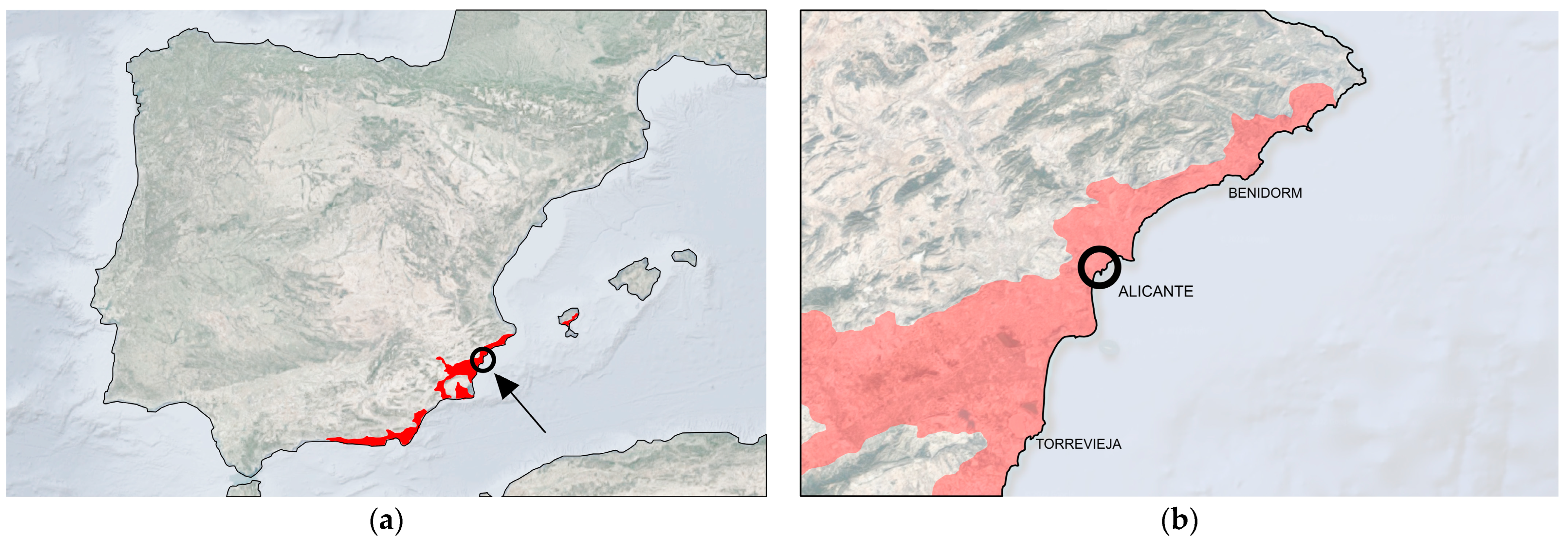
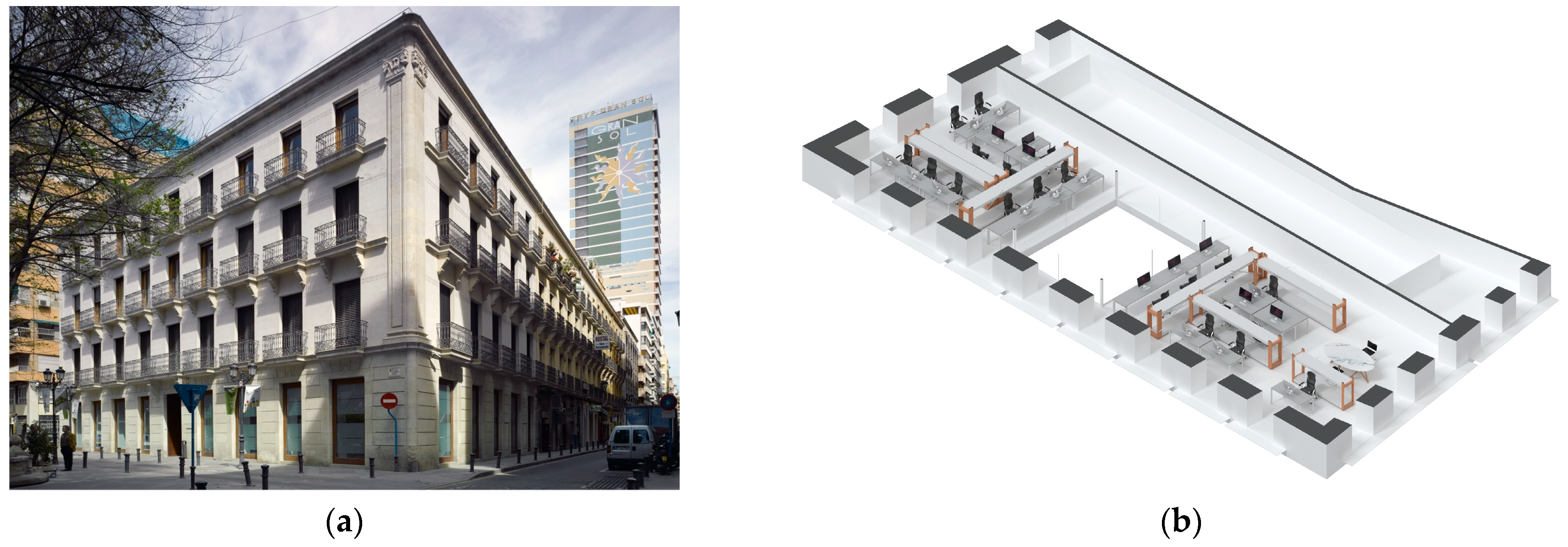
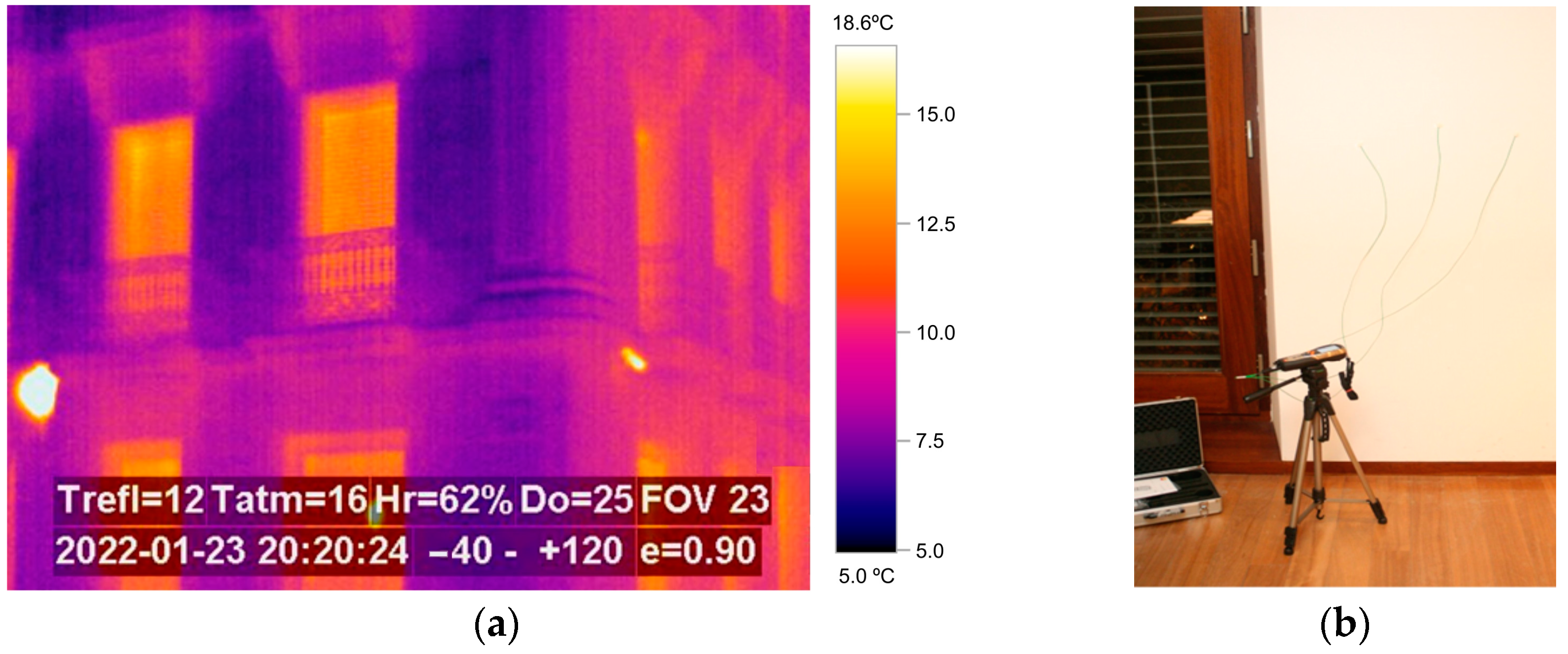
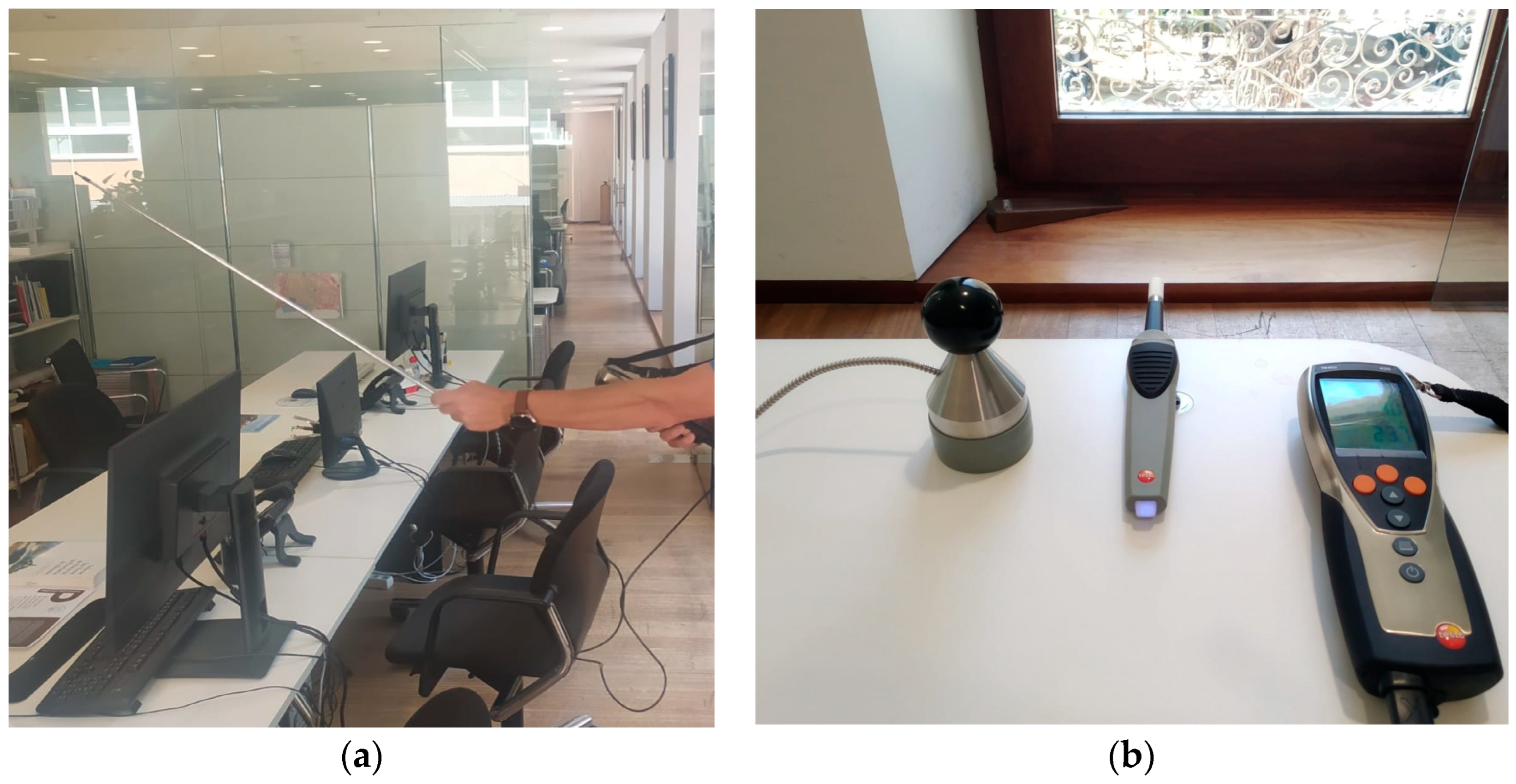
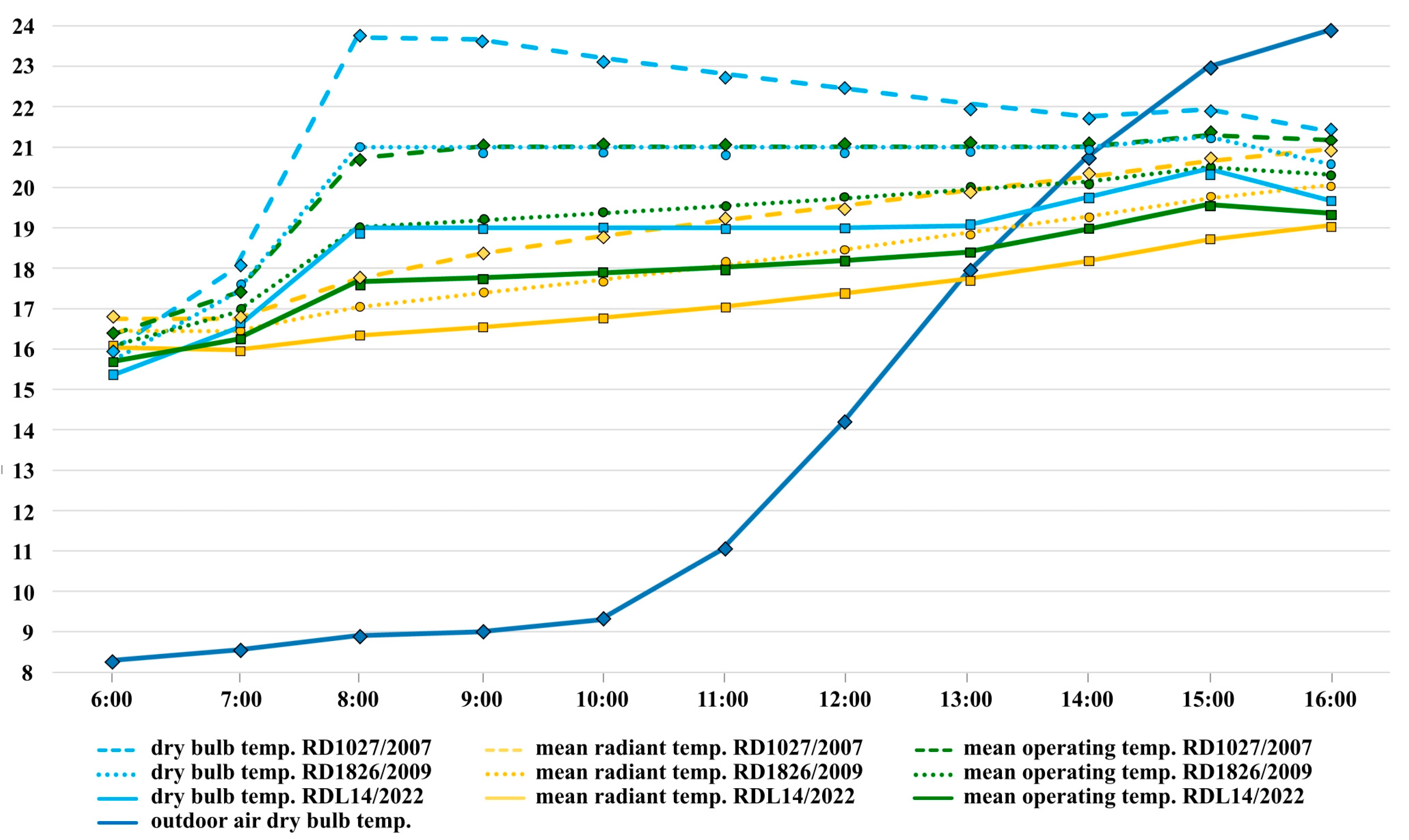
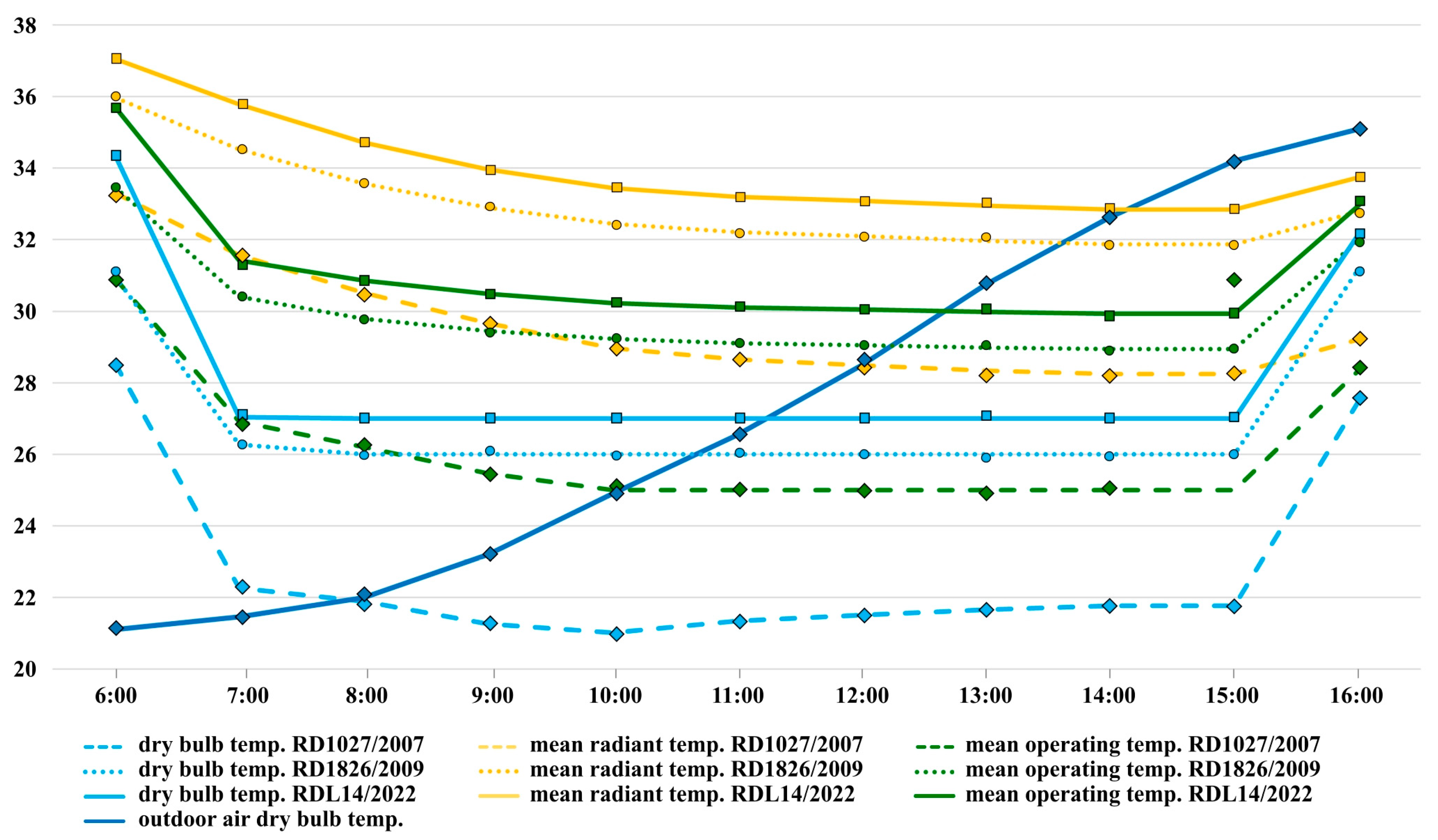
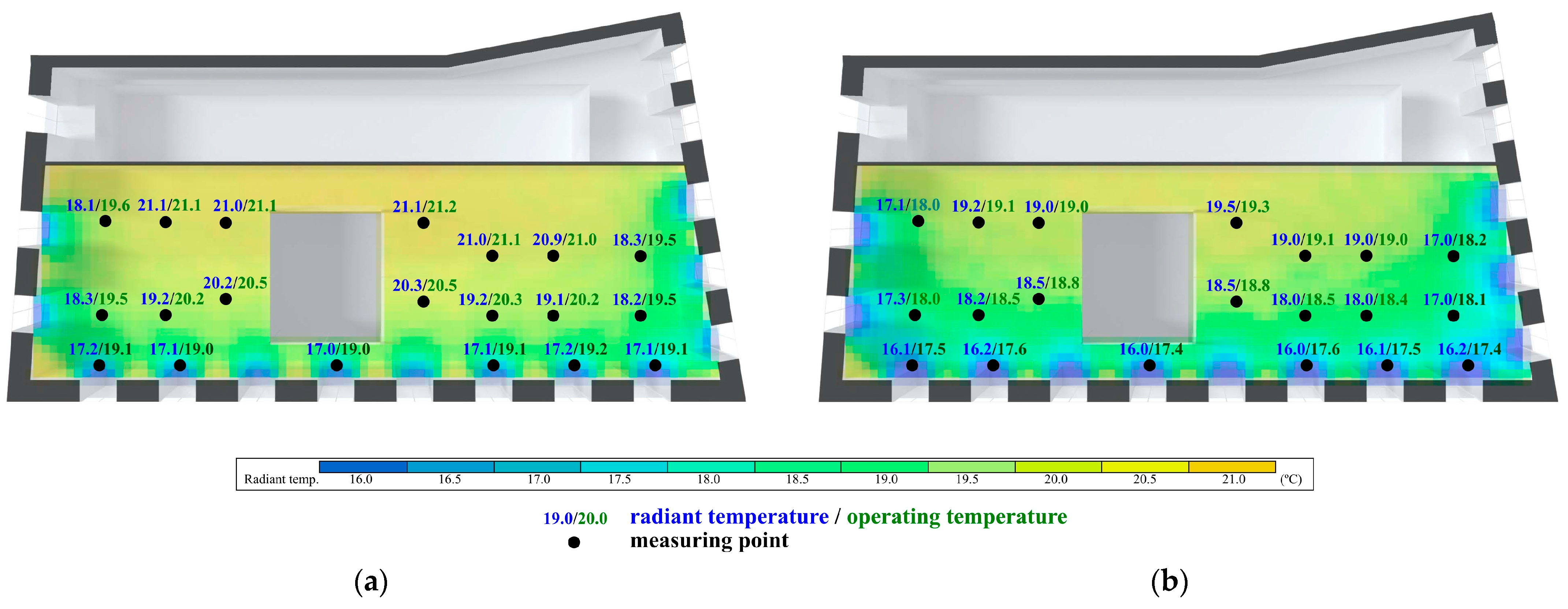
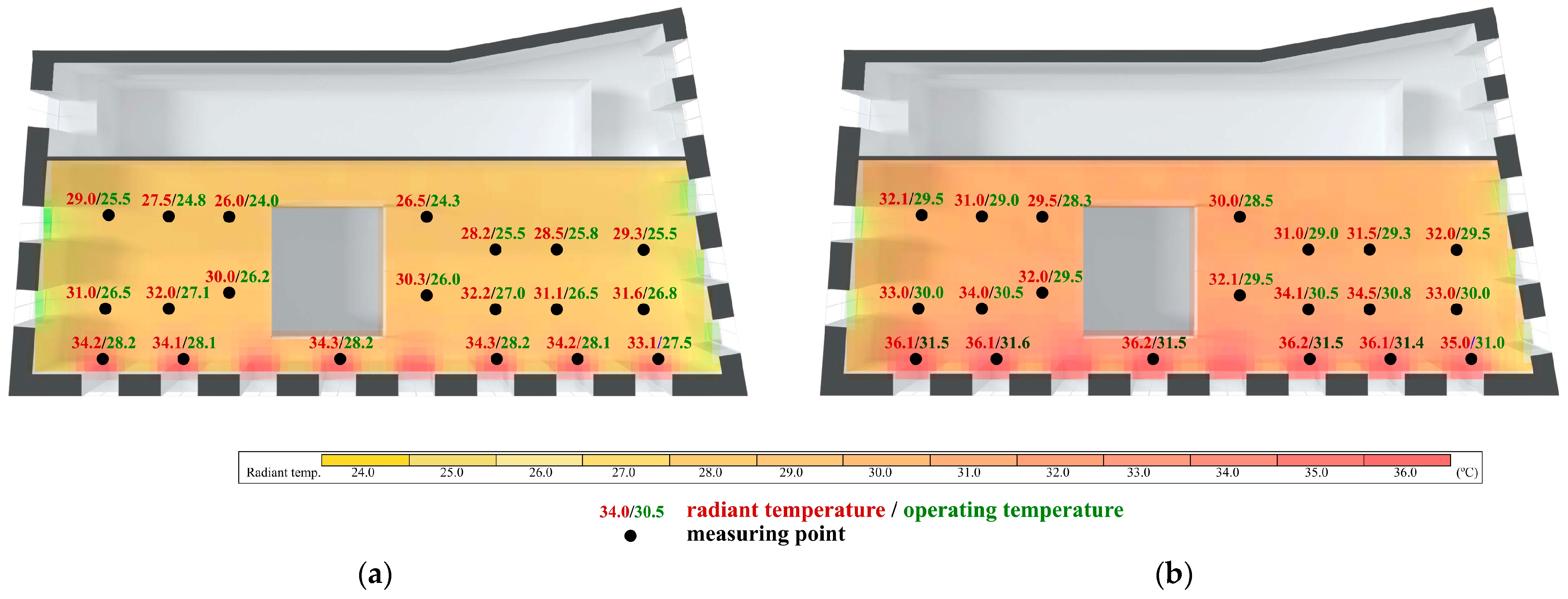
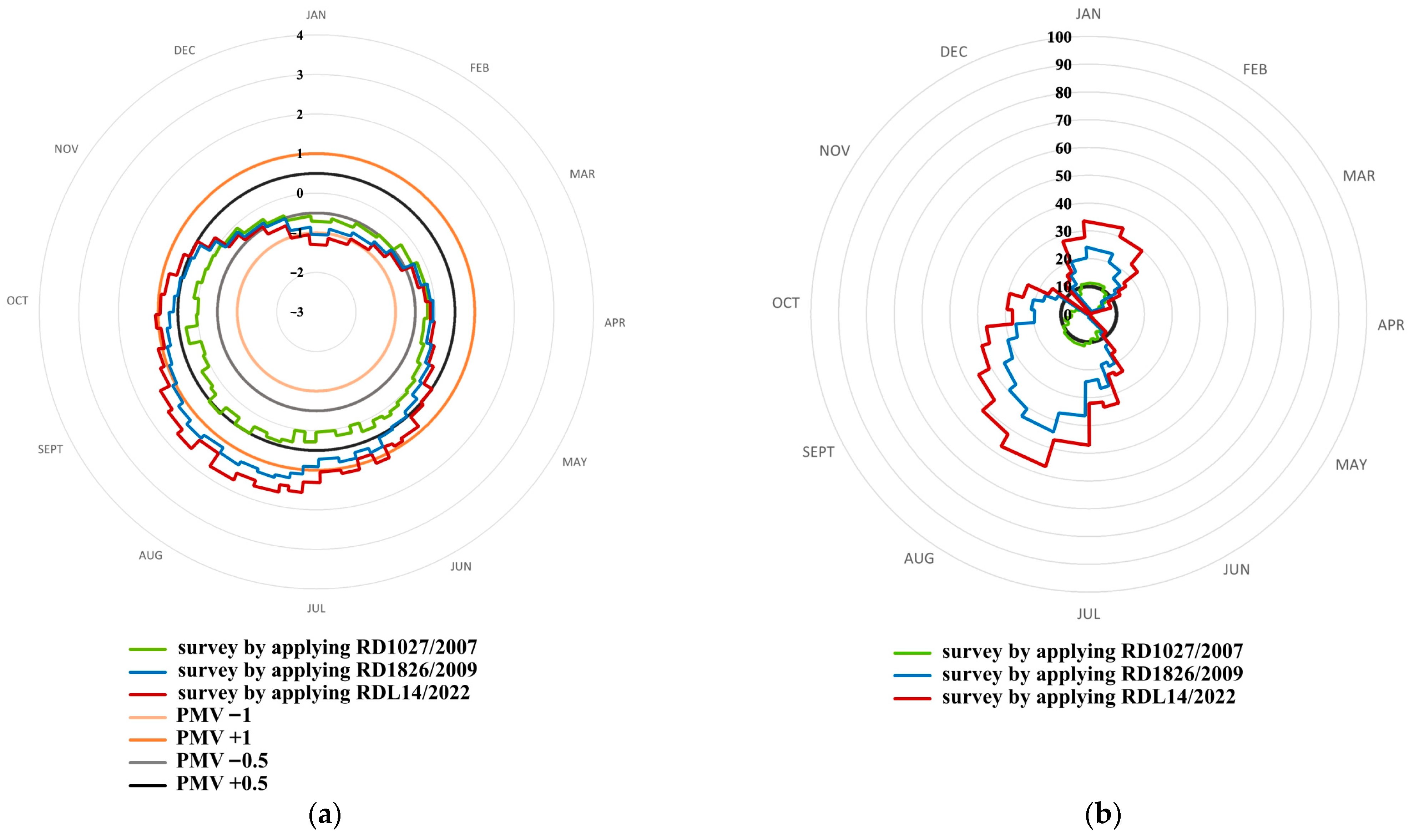
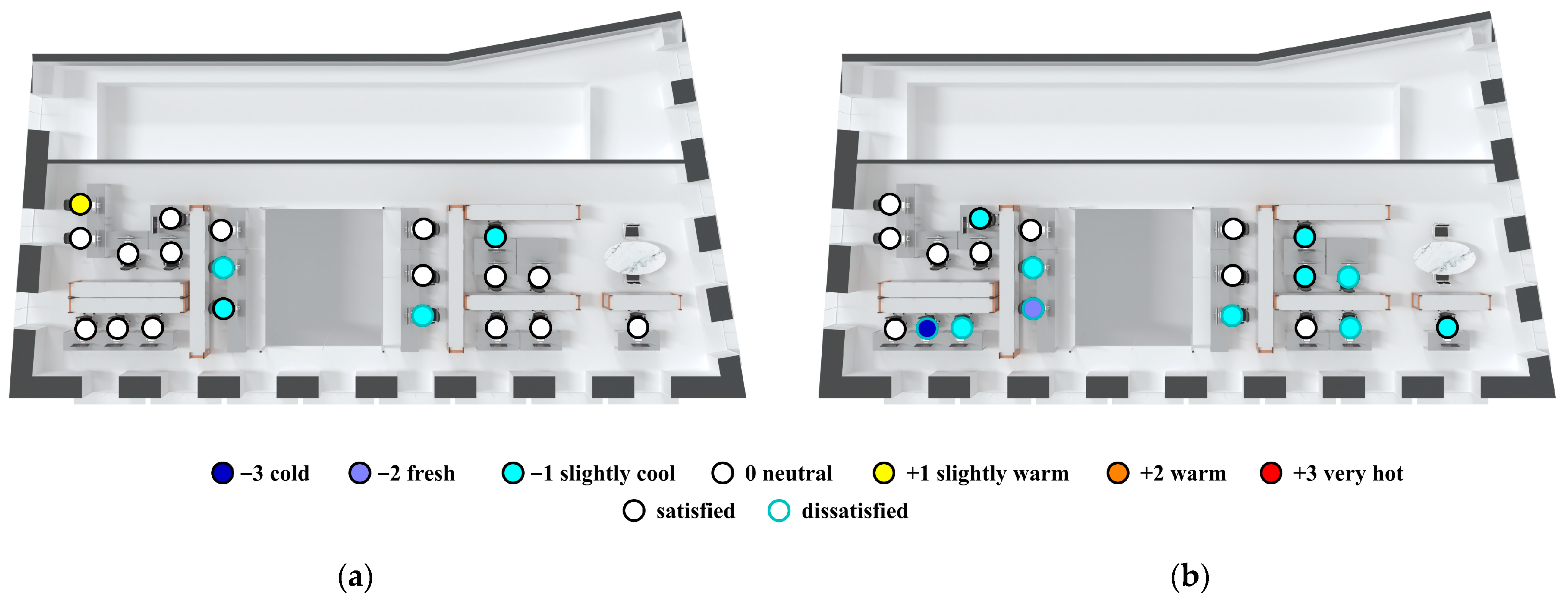
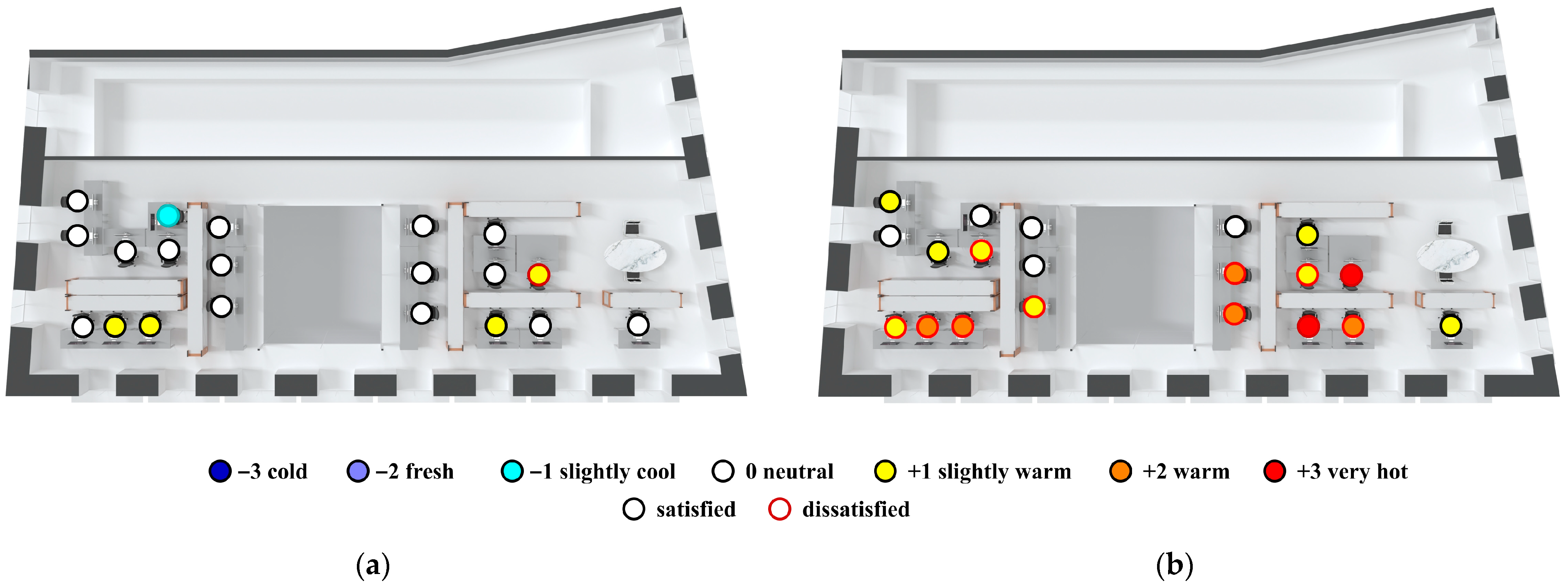
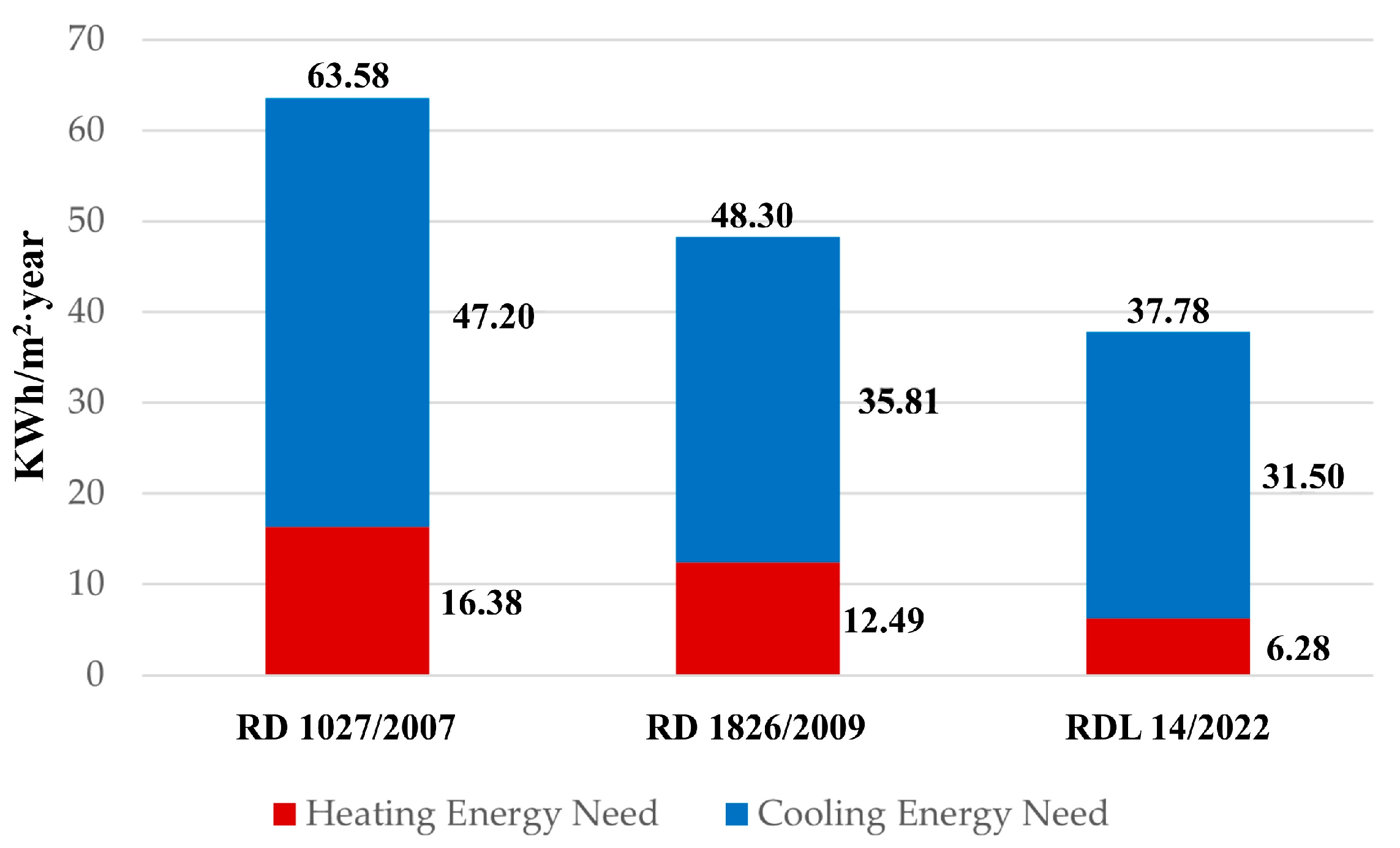
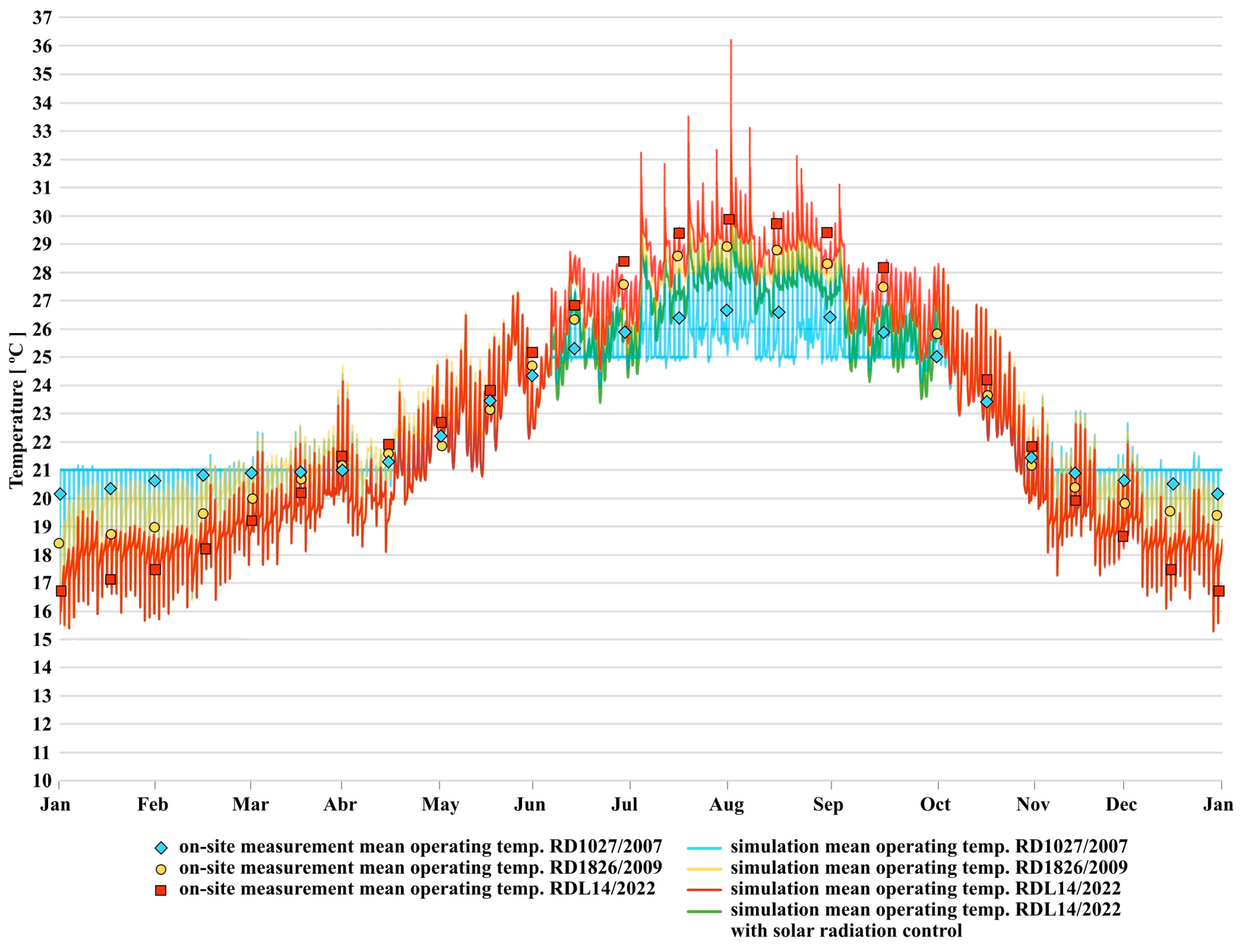
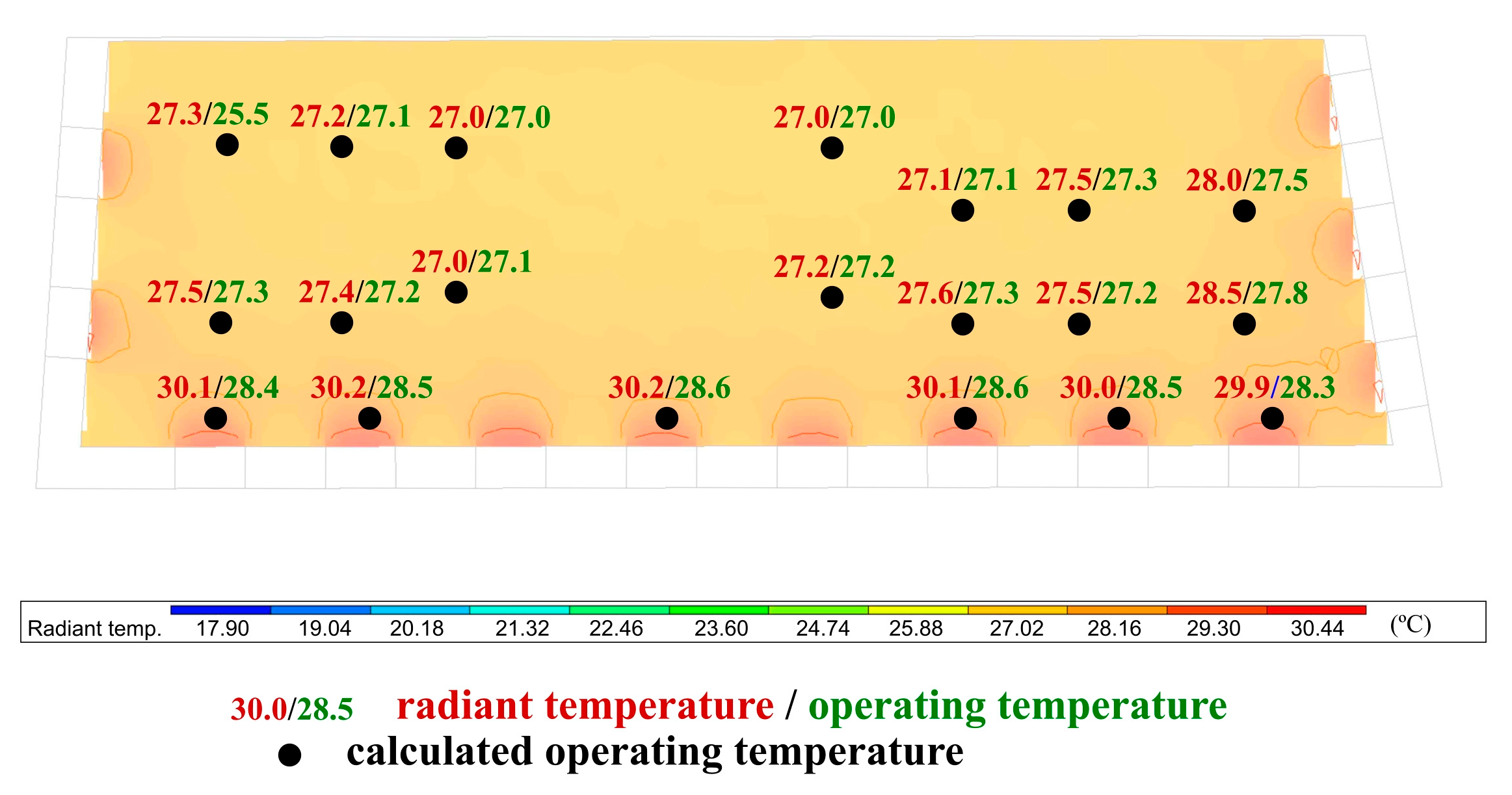
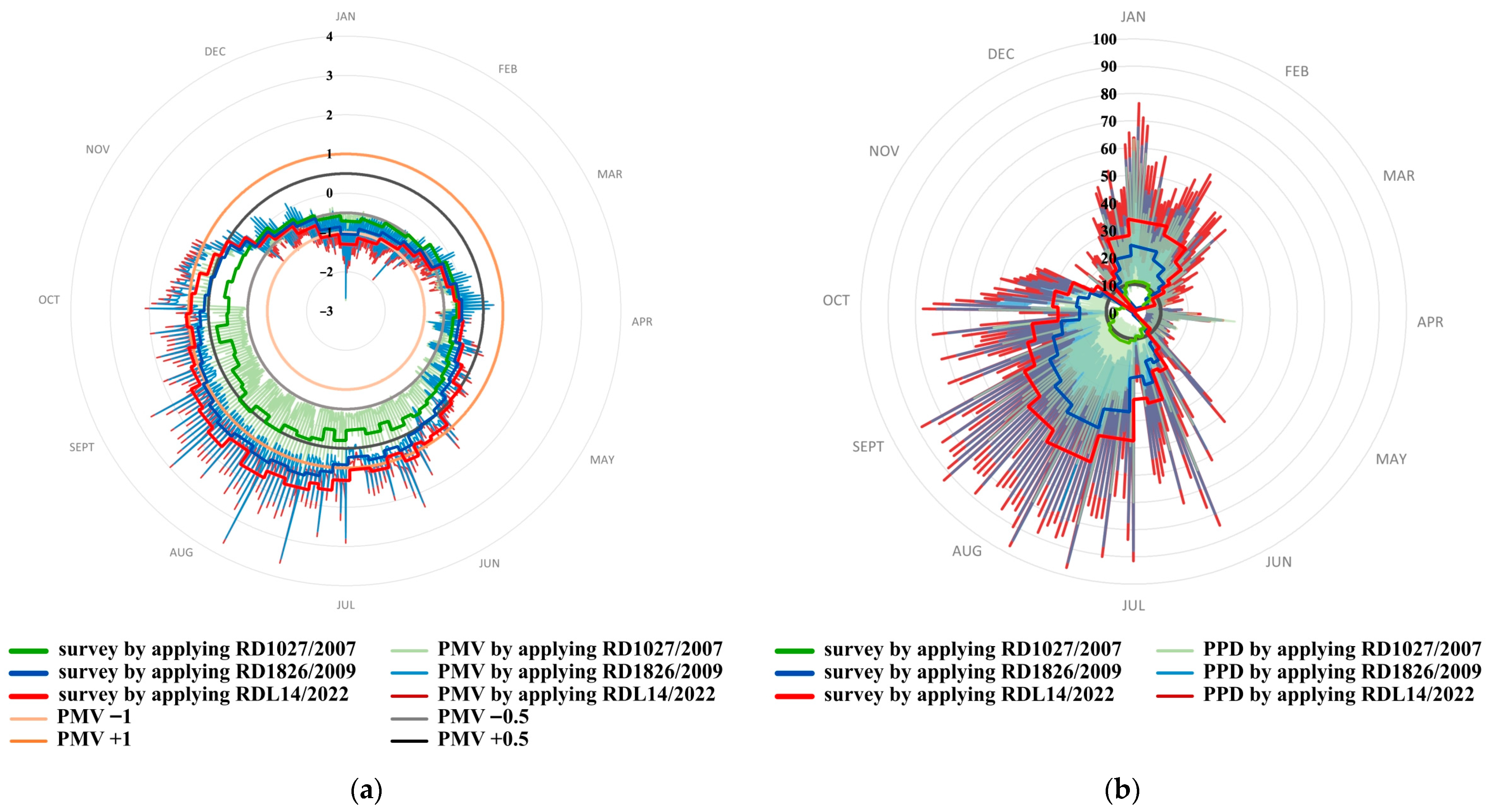
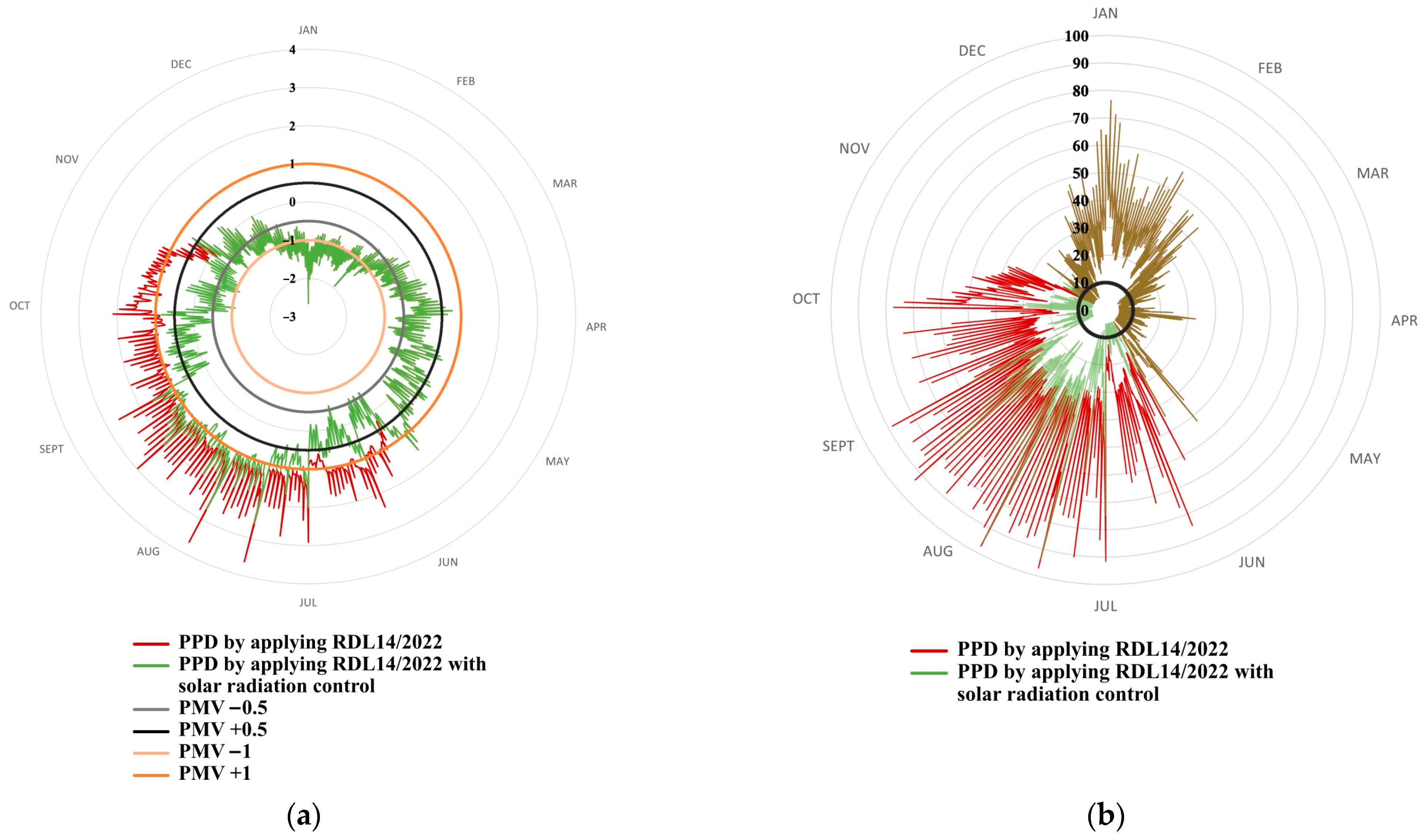

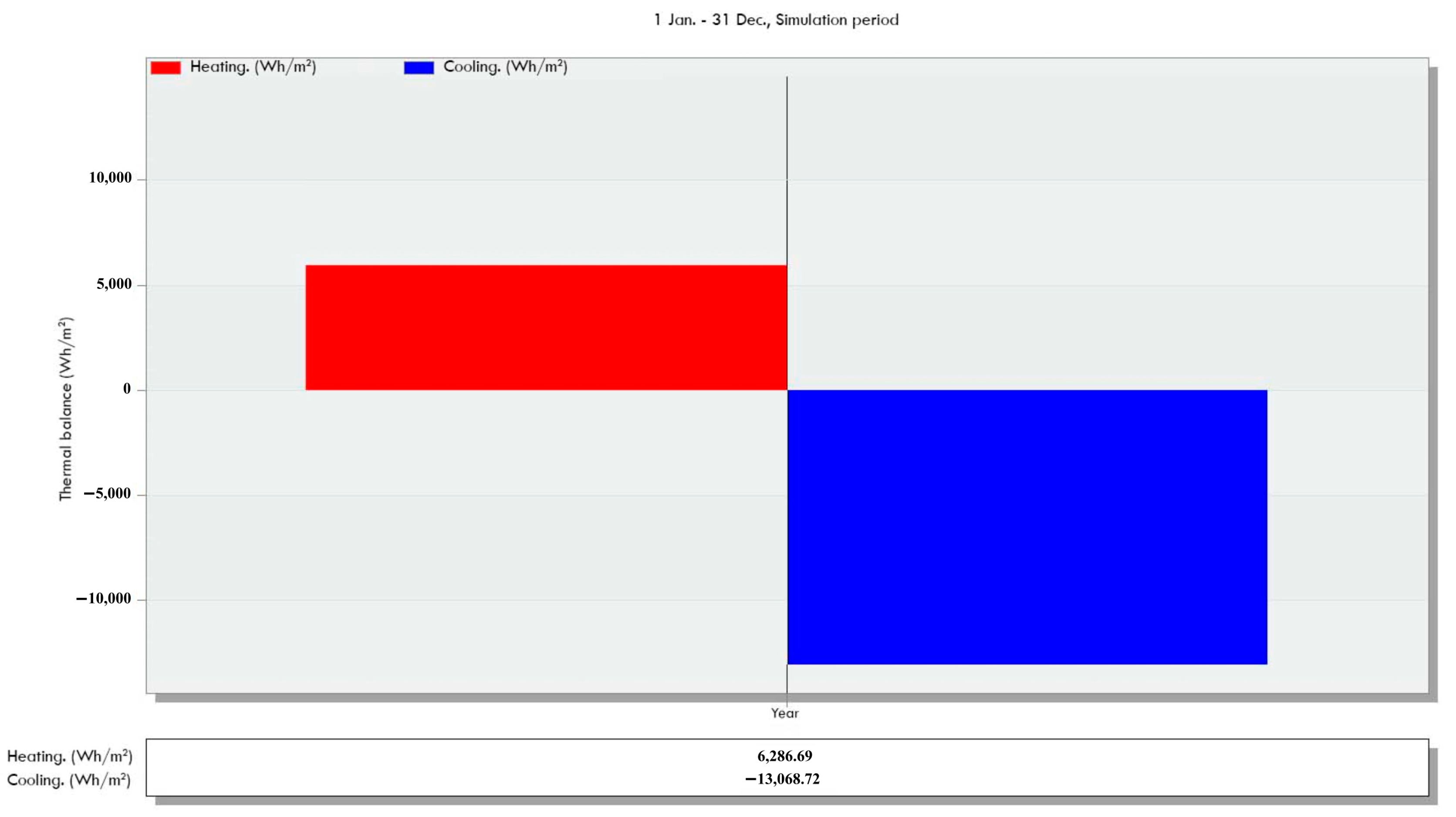
| Model | Measuring Range | Accuracy | |
|---|---|---|---|
| Thermographic camera | Testo 868 | −15–+50 °C | ±2 °C/±2% |
| +10–+95% HR | ±2% HR | ||
| Thermal transmittance flowmeter | Testo 435-2 | −20–+50 °C | - |
| Humidity/temperature probe | Testo | −20–+70 °C | ±0.3 °C |
| +10–+100% HR | ±2% HR | ||
| Surface probe | Testo | −20–+70 °C | ±0.1 °C |
| Hot-wire probe | Testo | −20–+70 °C | ±0.3 °C |
| ±0.3 m/s | |||
| Black globe temperature probe | Testo | +0–+120 °C | Class 1 (EN 60584-1) |
| Thermal Properties | Thickness (cm) | U (W/m2·K) | g | Absorptivity | Air Permeability m3/h·m2 |
|---|---|---|---|---|---|
| Opaque façade enclosure | 70 | U = 0.582 | |||
| Glass (80% of the window) | 2.0 | Ug = 2.543 | 0.85 | ||
| Frames (20% of the window) | 8.0 | Uf = 1.850 | 0.75 | 100.00 | |
| Floor | 40.0 | U = 0.90 | |||
| Roof | 55.0 | U = 0.65 | |||
| Air change rates by natural ventilation = 0.7 ren/h | |||||
| Frame air permeability = 50.00 m3/h·m2 |
| Winter Operating Temperature (°C) | Summer Operating Temperature (°C) | Winter Dry-Bulb Temperature (°C) | Summer Dry-Bulb Temperature (°C) | |
|---|---|---|---|---|
| Case 1 (RD 1027/2007) | 21–23 | 23–25 | - | - |
| Case 2 (RD 1826/2009) | - | - | max. 21 | min. 26 |
| Case 3 (RDL 14/2022) | - | - | max. 19 | min. 27 |
| Parameter | Applicable Regulation | |||
|---|---|---|---|---|
| People/m2 | Metabolic rate | Schedule | DB-HE | |
| Occupation | 0.13 | 1.3 | 07:00–15:00 working | Application Guide 2019 [65] |
| Cop | Months | Schedule | DB-HE Annex D | |
| Cooling equipment | 4 | 6/7/8/9 | 07:00–15:00 27 °C | Operational conditions and |
| Heating equipment | 3.5 | 1/2/3/4/5/10/11/12 | 07:00–15:00 19 °C | use profiles [66] |
| dm3/s | Schedule | RD1027/2007 [7] | ||
| Mechanical ventilation | 250 | 07:00–15:00 | RD1826/2009 [8] | |
| RDL14/2022 [2] | ||||
| Average illumination | Power | |||
| Internal lightning loads | 400 lux | 4 W/m2 | 07:00–09:00 50% | Royal Decree 486/1997 |
| 09:00–14:00 100% | Annex IV [67] | |||
| 14:00–15:00 50% |
| Parameter | Applicable Regulation | |||
|---|---|---|---|---|
| Type of control | Thermal property | Geometric property | ||
| Emissivity | Distance to glass | |||
| Window shading | Indoor air temperature. | 0.20 | 15 cm | DB-HE [57] |
| Standards | Dry-Bulb Air Temperature (°C) Average (Min–Max) | Mean radiant Temperature (°C) Average (Min–Max) | Operating Temperature (°C) Average (Min–Max) |
|---|---|---|---|
| RD 1027/2007 [7] | 22.5 (16.1–23.5) | 18.8 (16.8–20.8) | 21.0 (16.5–21.3) |
| RD 1826/2009 [8] | 21.0 (15.6–21.3) | 18.2 (16.5–20.0) | 19.5 (16.1–21.3) |
| RDL 14/2022 [2] | 19.0 (15.3–20.5) | 17.5 (16.0–19.0) | 18.0 (15.8–19.7) |
| Standards | Dry-Bulb Air Temperature (°C) Average (min–max) | Mean Radiant Temperature (°C) Average (min–max) | Operating Temperature (°C) Average (min–max) |
|---|---|---|---|
| RD 1027/2007 [7] | 22.1 (21.0–28.5) | 29.2 (28.2–33.4) | 25.0 (25.0–30.8) |
| RD 1826/2009 [8] | 26.0 (26.0–31.1) | 32.8 (31.9–36.0) | 29.4 (29.0–33.4) |
| RDL 14/2022 [2] | 27.0 (27.0–34.5) | 33.5 (32.8–37.2) | 30.6 (30.0–35.8) |
Disclaimer/Publisher’s Note: The statements, opinions and data contained in all publications are solely those of the individual author(s) and contributor(s) and not of MDPI and/or the editor(s). MDPI and/or the editor(s) disclaim responsibility for any injury to people or property resulting from any ideas, methods, instructions or products referred to in the content. |
© 2023 by the authors. Licensee MDPI, Basel, Switzerland. This article is an open access article distributed under the terms and conditions of the Creative Commons Attribution (CC BY) license (https://creativecommons.org/licenses/by/4.0/).
Share and Cite
Pérez-Carramiñana, C.; Sabatell-Canales, S.; González-Avilés, Á.B.; Galiano-Garrigós, A. Influence of Spanish Energy-Saving Standard on Thermal Comfort and Energy Efficiency Owing to the War in Ukraine: Case Study of an Office Building in a Dry Mediterranean Climate. Buildings 2023, 13, 2102. https://doi.org/10.3390/buildings13082102
Pérez-Carramiñana C, Sabatell-Canales S, González-Avilés ÁB, Galiano-Garrigós A. Influence of Spanish Energy-Saving Standard on Thermal Comfort and Energy Efficiency Owing to the War in Ukraine: Case Study of an Office Building in a Dry Mediterranean Climate. Buildings. 2023; 13(8):2102. https://doi.org/10.3390/buildings13082102
Chicago/Turabian StylePérez-Carramiñana, Carlos, Samuel Sabatell-Canales, Ángel Benigno González-Avilés, and Antonio Galiano-Garrigós. 2023. "Influence of Spanish Energy-Saving Standard on Thermal Comfort and Energy Efficiency Owing to the War in Ukraine: Case Study of an Office Building in a Dry Mediterranean Climate" Buildings 13, no. 8: 2102. https://doi.org/10.3390/buildings13082102
APA StylePérez-Carramiñana, C., Sabatell-Canales, S., González-Avilés, Á. B., & Galiano-Garrigós, A. (2023). Influence of Spanish Energy-Saving Standard on Thermal Comfort and Energy Efficiency Owing to the War in Ukraine: Case Study of an Office Building in a Dry Mediterranean Climate. Buildings, 13(8), 2102. https://doi.org/10.3390/buildings13082102






